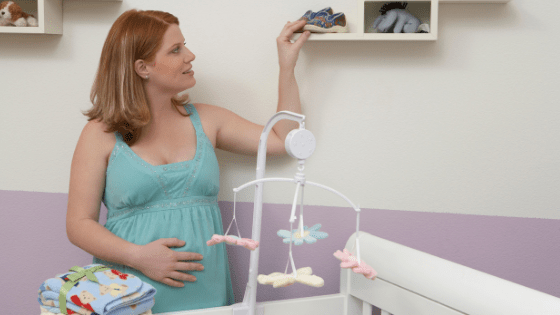Does your baby care about the color of his or her room? You bet he or she does.
Yes, infants have a small number of things to worry about, such as feeding and chewing on things. However, several research studies have demonstrated that the color of a baby’s room goes long way in determining how an infant will react to different ambiances.
The color goal is to soothe your baby’s restless soul. However, babies respond differently to the same colors. Let’s review the mood promoted buy six popular room colors, and then present a few tips to ensure you select the best color for your baby.

6 Popular Baby Room Colors
Red
Red exudes passion and energy, as well as immediately attract the attention of the most aloof infants. The color of excitement typically works best as an accent, not as the dominate color that runs wall to wall
Yellow
The color of the sun on most days encourages cheerfulness, which is exactly what most parents want out of their babies. However, too much yellow or a yellow that is too bright can bother sensitive infants.
Orange
As a warm, cozy feeling, orange encourages an inviting ambiance that puts active infants at ease. A darker orange is ideal for capturing the most interpersonal ambiance.
Blue
Blue is the color of healing, which means it works great for babies that need reassurance in a strange, new world. Calm is the word for blue and for most parents, raising a calm infant is important.
Pink
As the color that fosters loving relationships, pink is the perfect color for babies that tend to throw more than average number of fits. Remember that pink works just as well for boys as it works for girls.
Green
Serene green presents the best virtues of nature: verdant grass and gentle breezes. If you install some type of chime in your baby’s room, coloring the walls green will accentuate the calming, natural ambiance.
Selecting the Best Color for an Infant’s Room
Choosing the right color for your baby’s room should not be a guessing game. After all, what happens when all the hard work goes to waste when your infant dislikes the color of his or her room? The first tip for selecting the right color for an infant’s room is to test drive different colors at a home interior décor store or at the interior décor department of the local home improvement store. Many home improvement stores offer virtual room designers to present customers with different room appearances.
Here are a few more tips to ensure your baby love the color of his or her room:
It’s a Long Term Deal
Babies grow fast, which means coloring a room just to appease an infant might not be a wise home improvement investment. Instead, think long term when it comes to applying a color or two to your baby’s room. You can go with subtler colors that transition flawlessly when your infant grows out of the crib and allows you to put away the port a potty.
Boldly Go with Accents
As we mentioned, bold colors like red work best as complementary accents. For example, you can paint the interior of each wall blue and then use red on the perimeter of the walls to create a bolder ambiance. In a smaller room, well applied colored accents increase depth, which makes the baby’s bedroom appear much larger.
Light Matters
Most colors change appearance when natural or artificial light flows into a room. If you place your infant’s crib next to a window on the side of the house that is exposed the most to the sun, then you have created a bright and lively ambiance. You can balance the sunlight with a darker color such as blue or purple. Artificial light also influences the ambiance of a room, but it is not as much of an influence as sunlight.
Decide on a Theme First
If choosing the right color or colors for your baby’s room causes too much debate, then you can instead opt for a theme for the room. Another feature of a virtual room designer is presenting different room decor themes. For instance, if you prefer a more natural appearance for your infant’s room, you can choose one or more warmer colors to complement the rustic ambiance.

Balance is the Key
Creating a balanced ambiance for your baby’s room requires thinking hard about limiting the color of the room to one major shade, as well as possibly one or two colors that complement the primary color as accents. Too much blue or too much red sends an infant into sensory overload. Follow the 60-30-10 color rule, with the primary color taking up about 60% of the walls and ceiling, the secondary color filing in 30% of the room, and the accent color comprising 10% of the total room colors.
Above all, be very selective in the paint that you buy. Start with a small can of paint and apply a little of the color to a remote area of the room and if you like the color, bring home larger quantities of the same color. More important, purchase VOC-free paint to optimize a healthy room environment.
Benefits of Using a Virtual Room Designer
Using a virtual room designer offers several benefits:
- Saves money
- Delivers the right design
- Presents a visual reenactment of room décor
- Supports the use of fabrics and carpeting
The importance of visualization cannot be overstated. It allows you to see exactly how your baby’s room will look after it undergoes a long lasting paint job. Although a virtual room designer is not helpful in determining how your infant will react to a room design, it is a great starting point for you to narrow down the number of color options you have for painting your baby’s room.
Using a virtual room tool to help you when designing can save you hundreds of dollars by preventing the selection of a room color that simply does not work for your baby. It also gives you more options to pair a room color with different styles of drape fabric and wall to wall carpeting.
 Kaboutjie SA Mommy Blogs by Lynne Huysamen
Kaboutjie SA Mommy Blogs by Lynne Huysamen





Very helpful advice on this website will definitely recommend it
Very helpful advice will definitely recommend this website
Beautiful colors
Thank you for this lovely article